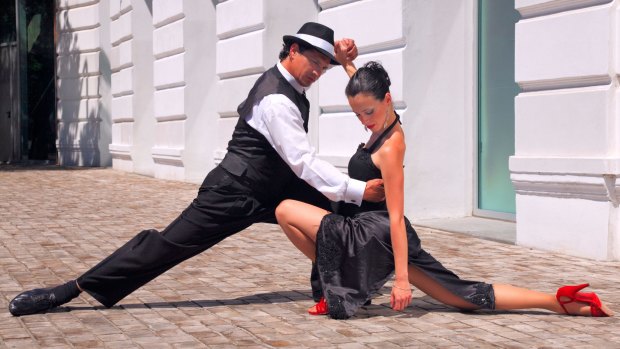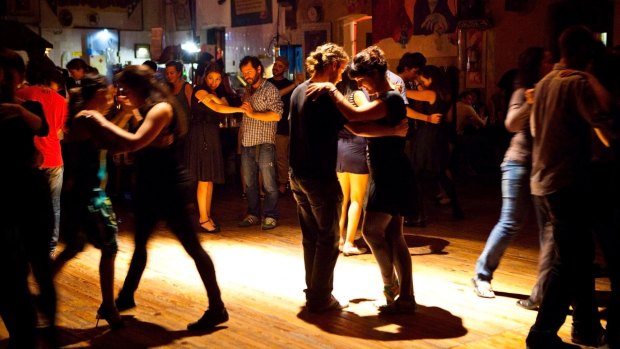
Dancers performing the tango at La Boca, Buenos Aires.Credit: Alamy
It's intimidating, without doubt. You only have to watch the faces of those who can do it, to see the emotion and passion filling their eyes as they glide around the dance floor, to know how seriously Argentinians take tango.
This is not just a dance. It's an expression of culture, lust, sadness and patriotism. It's a source of national pride, an art form, and I'm about to attempt it.
Fortunately, it's dark tonight at La Catedral, a Buenos Aires dance hall with a grandiose name that doesn't quite match its artfully shabby decor. This was once a warehouse, a cavernous space in the suburb of Almagro. Now, its bare floorboards play host to dancers, those who tango and those who wish they could.
The tango is a dance that was born in Argentina, and continues to flourish in concert venues and milongas, or community dance halls, across the country, particularly in the capital. Many tourists come to Buenos Aires to watch this intoxicating ritual, but how many learn to do it?
It's easy to miss the entrance to La Catedral. There's no sign, just a doorway and set of stairs in a quiet street. I wander up the dark stairwell and find a desk, where I'm pointed through a door marked with a red papier-mache heart. So far, no one has spoken any English.
The room at La Catedral is cavernous and quaint, its high wooden walls covered in posters and art works, mismatched tables and chairs gathered near a makeshift bar, and a few spotlights glowing on the dance floor. I order a glass of red wine – $2, I love this place already – take a seat, and watch nervously as a group of dancers shuffles around the floor to the instructions, in Spanish, of a legging-clad teacher. These guys aren't good, but they're competent.

Aspiring tango dancers practise their moves in La Catedral hall in Buenos Aires.Credit: Alamy
This is bad news, because I'm not a dancer. I can't even fake my way through a waltz, let alone commit my soul to a tango. The crowd on the dance floor, meanwhile, is moving through a series of complicated steps, twirling, dipping, and swinging, and then they're walking, mercifully, off the floor. I take a couple of gulps of wine for courage, and make my way with about 20 more people into the dance area to begin my lesson.
It's in Spanish, mostly. There's a smattering of English, which is handy given that most of the other dancers appear to be American exchange students who have about as much idea of tango as I do.
Fortunately, their Spanish is much better than their dancing, so I can get the odd translation as we form a large circle and practise stepping in time to the music, feeling, at least, the rhythm of tango, even if we can't yet harness it.
We then partner off and form two large circles, moving clockwise and then anti-clockwise together, getting used to the feeling of dancing with a partner, stepping in time, changing direction in time, taking things as simply as possible.
You know what? It's magical. Just this rudimentary attempt at dancing the tango is so much more of an experience than watching it. All of a sudden you feel part of the passion that portenos, the residents of Buenos Aires, have for this dance.
Next we're practising leading, the women putting their hands on the men's torsos, the men pushing them around the dance floor, leading with chests as proudly puffed out as a professional footballer. Again, it's intoxicating – the rhythm, the emotion.
All too soon the lesson is over and I make my way back to the street, catching a taxi to Salon Canning, a traditional milonga in the heart of nearby Palermo. It's 11pm now, and the place is packed, the dance floor full as couples indulge in their passion.
The plan had been for me to try out a few steps here, but seeing the emotion and dedication on the faces of the local dancers, I resign myself to a seat, a bottle of red wine and the enjoyment of watching the pros.
MORE INFORMATION
GETTING THERE
LAN Airlines flies daily from the east coast of Australia to Santiago, Chile, with onward connections to Buenos Aires. Phone 1800 126 038 or see lan.com.
DANCING THERE
Tango lessons and a live show are available as part of Chimu Adventures' Buenos Aires Stopover package, which also includes a city tour, airport transfers and three nights' accommodation. Prices from $575 a person. See chimuadventures.com.au.
The writer was a guest of Chimu Adventures.
Sign up for the Traveller Deals newsletter
Get exclusive travel deals delivered straight to your inbox. Sign up now.